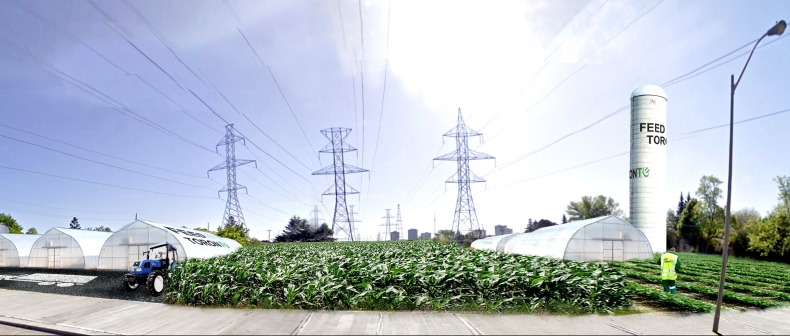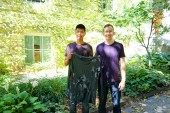
Grandiose proposals to improve life in the city are not in short supply. Usually we point our attention at the most far-fetched ideas, tear them to shreds for being unrealistic and then lament how nothing ever gets done around here. So how do you get a grounded idea off the ground? A team of graduates from University of Toronto’s Daniels Faculty – Drew Adams, Fadi Masoud, Karen May, Denise Pinto and Jameson Skaife – has an award-winning project for the City of Toronto that they think could harness one of the region’s underused resources to help feed a hungry city in a sustainable way. Now that they’ve won a National Urban Design award, hopefully somebody will start to take them seriously.
Feed Toronto envisions transforming the GTA’s Hydro corridors from swaths of open grassland into operating farmland that could grow food for the people of Toronto. The plan calls for the City to establish an arms length organization in the vein of Build Toronto and Invest Toronto called Feed Toronto as well as zoning provisions that make sure the scale of the farm would be appropriate to the surrounding areas so, for example, busy commercial farms wouldn’t back onto private homes (read the whole plan in PDF).
But this ain’t no rinky-dink operation. The numbers offered by the Feed Toronto team are staggering:
- 8,145 acres of land — greater than the area bounded by the Don River, Humber River, Lake Ontario and Bloor Street
- 181,716 tons of food per year
- $624,120,000 potential annual wholesale revenue
“You’ve got this huge public infrastructure that is a mowed lawn for the most part and it’s a staple in every North American city why not focus there where you kind of get more bang for your buck,” Adams says adding, “It’s just crazy how much space it actually occupies. You don’t really realize how much space it is until you start to add it up.”
Unlike other urban farming schemes that imagine skyscrapers filled with pigs, Feed Toronto is noteworthy because of its viability. They won a 2012 National Urban Design Award because of it. The Jury comments read, “Feed Toronto is a visionary, remarkably mature, and refreshing student project. Instead of aesthetic experiments, the students choose to pursue a less spectacular but ambitious and generous task.”
Anticipating criticism, the team proactively looked for responses to the kneejerk reactions they thought they would come up against. “We were worried that initially some of the opposition might come from a misunderstanding that there’s radiation or there’s EMF (electromagnetic field) and that the food growing there wouldn’t be edible,” Pinto said. The team sought out Peter Valberg, an environmental consultant at Gradient Corp with years of research on the topic under his belt who assured them that EMF posed no threat to food or farmer safety.
As for using Toronto Hydro’s land, their proposal to take over land rights while the utility company maintains air rights ensures that the two uses could co-exist. “Right now for them it’s a lawn that they mow, something they have to maintain rather than a kind of asset,” said Adams.
But even with a grounded proposal, Feed Toronto has yet to move any closer from vision to reality. “I was talking to the urban design department at City of Toronto when we won the Toronto Urban Design award [in 2011],” Adams said, “and I was like, ‘Well who do I talk to, what do I do.’ And I don’t think there was as much traction then.”
The pair lists a number of parties they contacted, including a local Green Party candidate and a spokesperson at Toronto Hydro, from whom they never heard a response. “I don’t know if it’s a politically difficult move for them to comment on it in writing,” Pinto said. One thing Pinto does know is that there is huge demand for the kind of urban farming opportunities Feed Toronto would create. “I tried to get on a community garden wait-list and I couldn’t even get onto the wait-list so there’s demand for it in Toronto.”
Ever the pragmatist, Adams says he can understand the lack of response, “I think part of it is that you get a young person saying I’m a student in an ideas competition. When everyone is so busy, how serious are you going to take it and how much time are you going to take responding. So, we’re really grateful for the responses we did get.”
But Adams and the team are looking at their 2012 National Urban Design award as their foot in the door. “What I’m really hoping is going to come out of this recognition that we’ve just received is that it will lend some credibility to us when we go to talk to the people that need to be in these conversations and let them say this is a not just a whimsical thing but let’s move beyond the kneejerk reaction and look at this more seriously.”
Adams and Pinto admit that the project needs a champion. With the original design team now graduated and scattered across the world, Feed Toronto needs people and organizations willing to take up their cause. “If someone wants to start a demonstration project and they can get someone locally that’s going to support it in a local area, fantastic,” Adams said.
Besides hoping to see Toronto’s Hydro fields turned into farms, the goal behind Feed Toronto is to spark a larger discussion about food security in Toronto and beyond. Locally grown food, Pinto says, is going to be needed when importing food from around the world becomes too expensive. “It dovetails with all of these movements,” Pinto says. “Local food and sustainable food growing and with TDSB’s recent curriculum (PDF) on that, there’s some really nice partners that we can find in school boards and institutions.”
To get involved with Feed Toronto, contact feedtoronto@gmail.com
____
Michael Kolberg is The Sprawl Editor at Toronto Standard. Follow him on Twitter for jokes @mikeykolberg
For more, follow us on Twitter at @torontostandard and subscribe to our Newsletter.














